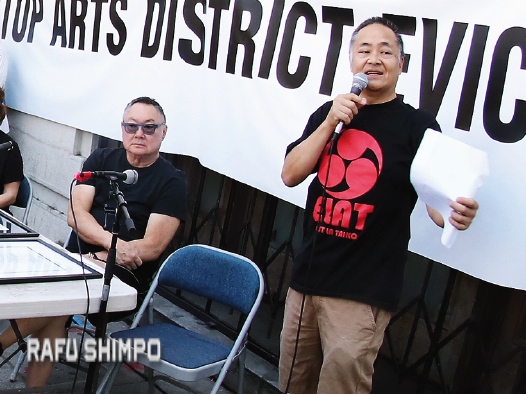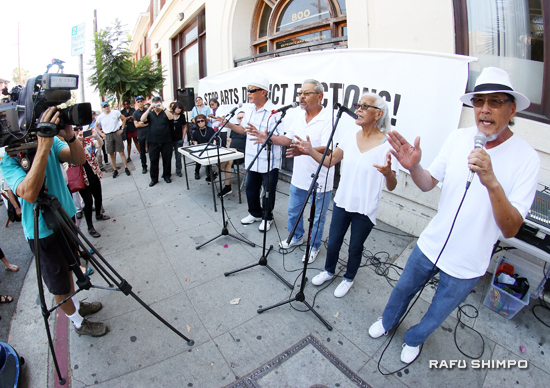‘AN ARTS DISTRICT WITH NO ARTISTS’
Stakeholders oppose evictions at 800 Traction St.
Posted On
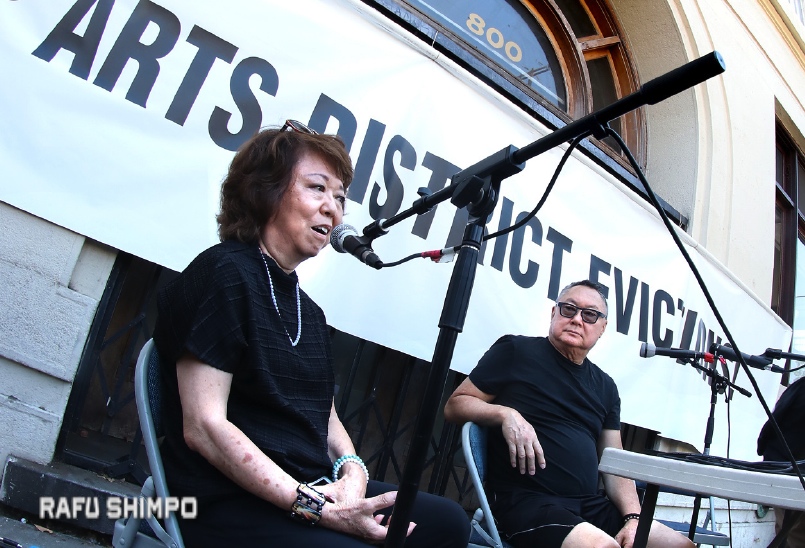
Artists Nancy Uyemura and Bruce Yonemoto, who reside at 800 Traction, spoke at the rally. (MARIO G. REYES/Rafu Shimpo)
By J.K. YAMAMOTO, Rafu Staff Writer
A coalition of Little Tokyo and Arts District stakeholders held a rally July 29 to support eight artists facing eviction from their homes at 800 Traction St. in L.A.’s Arts District.
The tenants, who have been part of the local arts community for decades, face eviction at the end of August by the century-old building’s new owners, DLJ Real Estate Capital Partners, a New York private equity firm whose leadership includes several executives of Credit Suisse, which bought the property for $20 million.
About 60 people attended the rally in front of the building, which opened with performances by members of Chikara Taiko and East L.A. Taiko and a performance of the ’70s hit “Wake Up Everybody” by Asian Persuasion.
“We’re going to stand with our friends and fight these evictions,” said Taiji Miyagawa, chair of the anti-eviction coalition, who has been active in anti-displacement work in other neighborhoods. “…We’re in a housing crisis of epic proportions, and it’s global phenomenon. Market forces driven by large capital interests, such as the owners of this building, are driving market rents skywards to where the people who built our communities can no longer afford to live in them …
“In particular, minority communities in L.A. are not only being impacted disproportionately, they’re being targeted for displacement. In these neighborhoods, rent now costs an average of 60 percent of people’s income, double what the measure is for what is defined as ‘affordable.’ The number of rent-controlled units taken off the market [in L.A.]rose 27 percent in 2016. Most people cannot afford the high-rise condo units being built in their place.”
Among those affected by this trend are lower-working-class families, senior citizens on fixed incomes, veterans, and small community-serving businesses, Miyagawa said.
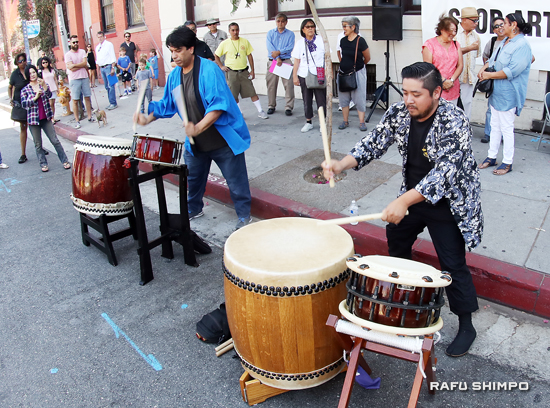
Maceo Hernandez of East L.A. Taiko and Walter Nishinaka of Centenary United Methodist Church’s Chikara Taiko performed. (MARIO G. REYES/Rafu Shimpo)
Reflecting on changes over the past three decades in the neighborhood, which has gone from deserted warehouses to condos and cafés, he noted, “These residents were among the earliest to move into the mostly industrial area here when it was run-down and grungy. They came here because rents were cheap and they could get space to work in. Residents here at 800 Traction were the first to receive ‘artist-in-residence’ designation at this building. They were among those central to the development of the area into what was officially designated by the city in 1990 as the Arts District. What we see today in the area is an extreme, advanced example of the trajectory of gentrification that’s sweeping the entire region.”
Miyagawa described the residents as “people who have been serving the local community here in Little Tokyo since they first moved in during the ’80s, enriching the cultural life, enlivening our community events, documenting our histories and encouraging critical discourse via exhibits at local venues such as the Japanese American Cultural & Community Center and Japanese American National Museum.”
Citing other community institutions on the east side of Alameda Street, including St. Francis Xavier Chapel-Japanese Catholic Center (Maryknoll), Zenshuji, Nishi Hongwanji and Fukui Mortuary, Miyagawa said that 800 Traction is part of local Japanese American history going back to the early 1900s.
“The workspaces of their lofts provide for art production facilities that do not exist elsewhere in Little Tokyo,” he continued. “In short, these artists and the building are assets that the Little Tokyo community cannot afford to lose … If we allow these residents to be evicted, we lose them from the community.”
Miyagawa mentioned Matsumi Mike Kanemitsu (1922-1992), “one of the greatest Japanese American artists that have ever crossed our path in this area. His archive is in this building. If that archive gets evicted, many people will never see the great works that he produced.”
Placing the evictions in a historical context that includes the mass incarceration in 1942, Miyagawa said, “Prior to the war, Little Tokyo used to extend to Los Angeles [Street] to the west, Ninth Street to the south, the L.A. River to the east, and Temple up to the north … We never really recovered after that. But we also ran through another wave of displacement in the ’70s and the ’80s … Japanese banks and corporations moved into Little Tokyo and we had a lot of low-income housing that was just decimated, a lot of small businesses went under.”
Taiji Miyagawa, leader of the anti-eviction coalition, speaks at the rally. (MARIO G. REYES/Rafu Shimpo)
He added that the Fugetsu-do confectionery on North First Street is facing the prospect of being priced out of business due to rising rents. “Because of market rates, small businesses that have been serving the community for generations are being driven out.
“So the artists are asking, what’s the point of an Arts District without artists? You can get your craft beer and everything, but the people who developed this area … they’re getting kicked out. It’s the same thing with Little Tokyo. Do you want a Little Tokyo that just has cultural artifacts as a façade but no Japanese Americans? …
“Our people deserve a right to housing … We must call for an expansion of rent control. We need a society that puts people over profits, and one that upholds housing as a right … We need a citywide moratorium on evictions and we can start by stopping the ones right here at 800 Traction.”
Artists Speak Out
Resident Nancy Uyemura, who was moved by the presence of so many friends and neighbors at the rally, said, “I’ve been here for so long and have had so many parts of my life — businesses, love, social events … that it’s really hard to imagine not being here … The rents have gone up so much we would really not find a place in Downtown to resettle and we would be really losing our participation in Little Tokyo. We’ve been here since before JACCC and before the museum and everything …
“We are the Arts District. We really helped create this place … We met with the new businesses coming in. We really embraced it. Our past landlords were just really great. They were very supportive of all the arts and there are so many artists that came through this building. So it’s a historical loss to our community as artists and as Japanese Americans.”
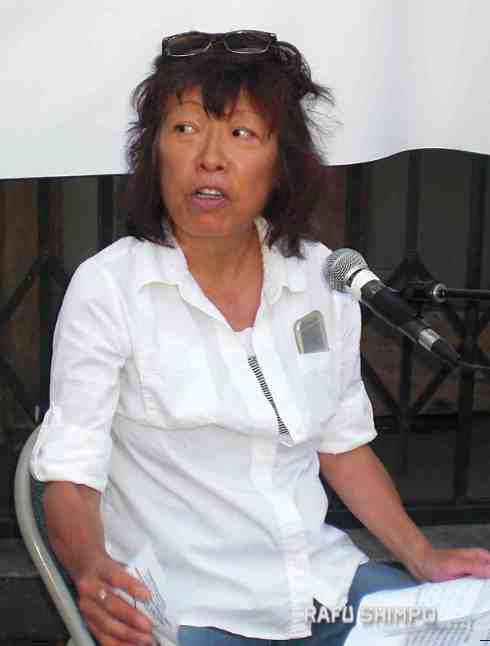
Artist and resident Aiko Baden (J.K. YAMAMOTO/Rafu Shimpo)
Multimedia artist Bruce Yonemoto said of the local Japanese American community, “It’s not as large as some of the other Asian communities, but it’s very strong. We do have the JANM and the JACCC here … and that’s the reason why I moved out here, to this particular building, in 1999 … I was having a retrospective at JANM, so to support the community and to support the organization I moved here. And now it’s so ironic that it’s the 75thanniversary of the incarceration where Japanese Americans were evicted from this place, and now it’s happening again … How many more times do we have to be evicted?”
Artist Aiko Baden, who graduated from the Otis Art Institute in the late 1970s, recalled, “My husband, who is a professional artist, and myself moved to this area 26 years [ago]and out of that, 24 years in this building … Along with our neighbor artists and residents, we live our lives here and we create … Now the recent changes in our neighbors really make us uncomfortable, and now this, evictions. Please be aware that these waves of new development take away our studios and our homes.”
Her husband, Stanley Baden, added, “I came to L.A. in the early ’80s because I was very interested in the art scene and I was very aware of all the pivotal artists in the L.A. area who have made such an incredible impact on the global arts community … L.A. was the place to really tap into that. There were spaces to work, there were opportunities … those initial artists … planted incredible seeds in this area, in this region …
Asian Persuasion performed “Wake Up Everybody,” which was recorded by Harold Melvin and the Blue Notes in 1975. (MARIO G. REYES/Rafu Shimpo)
“The big banks and developers are coming in to destroy that seed bank, so we’re losing the places to work. We have a printmaking studio in here … I teach at Pasadena City College. My students are in Boyle Heights, Highland Park, Lincoln Park, San Gabriel Valley. I know first-hand the talent pool that’s migrating in to this art scene. They have to have a place to work … This isn’t necessarily about us, this is about the big picture. It’s about the upcoming artists who need a place to function and can be part of this dialogue.”
Artist Mark Oberhofer, who moved to the east side of Alameda in 1990, when it was still considered a “no-go zone,” said, “The artists that were here tried to make it into something, and it was our dream … but we never thought that we would be evicted when it all happened like this. I understand that the owners of the building made some money, which is good, but the change is a little too much.”
Miles Hamada, an artist who works with organizations in Little Tokyo and the larger Asian American community, commented, “One of the reasons why I moved here was this space was affordable and close enough for me to be right in the center of action of this community. Now I’m being forced to move away … There is always change, but it’s at the cost of usually the small person. That’s us … We know the developers want to make money off of this area, but I think we still should maintain our place here as artists because this is what we came here to develop and have our residencies, shops, studios.”
Miyagawa acknowledged, “It’s going to be a tough battle. This building does not have the legal protection that a lot of buildings have like rent control, rent stabilization ordinances … It is pretty much a stereotypical David and Goliath type of story. But I have a lot of faith in the community.”
Petitions are being circulated online at: https://www.gopetition.com/petitions/stop-the-evictions-at-800-traction-avenue.html
For information on opportunities to get involved and to be notified of future events, contact Miyagawa at standwith800traction@gmail.com.
